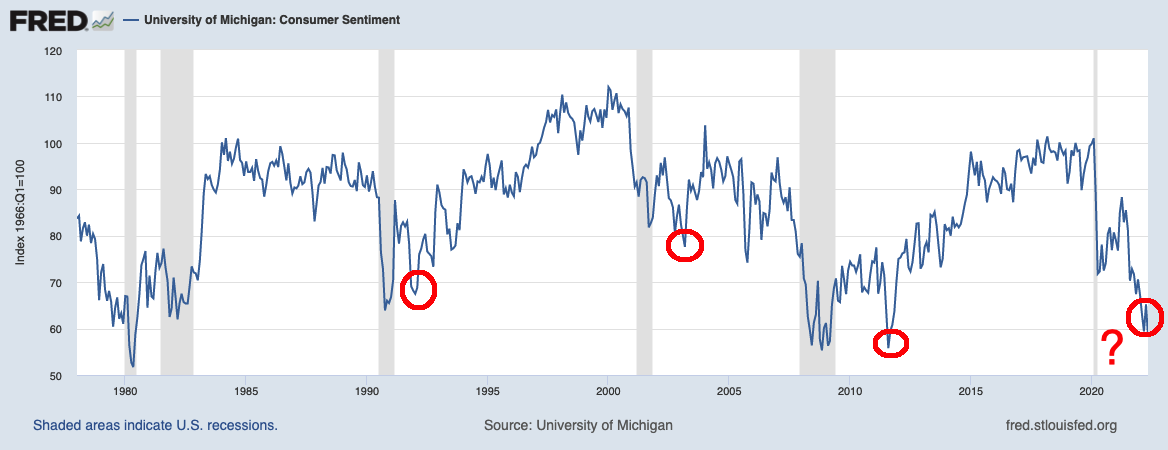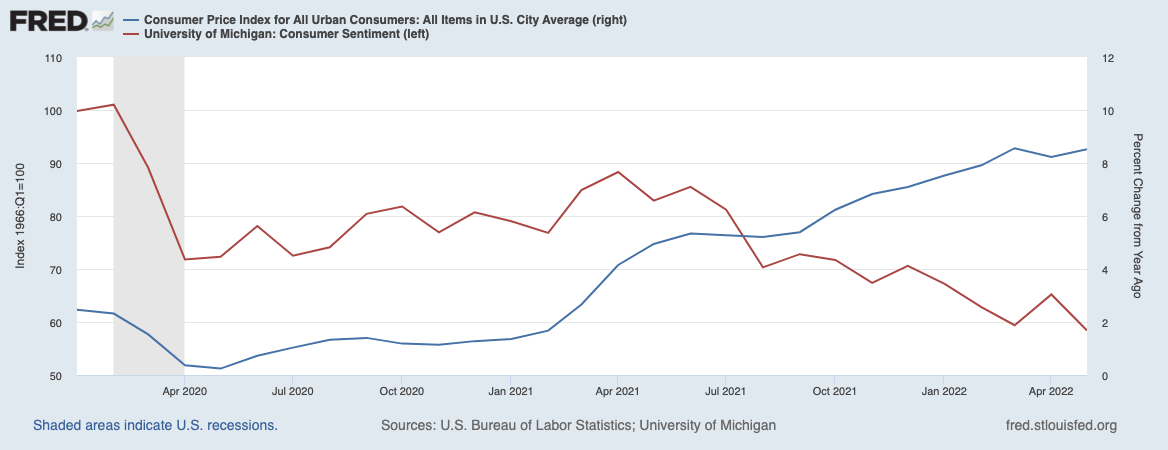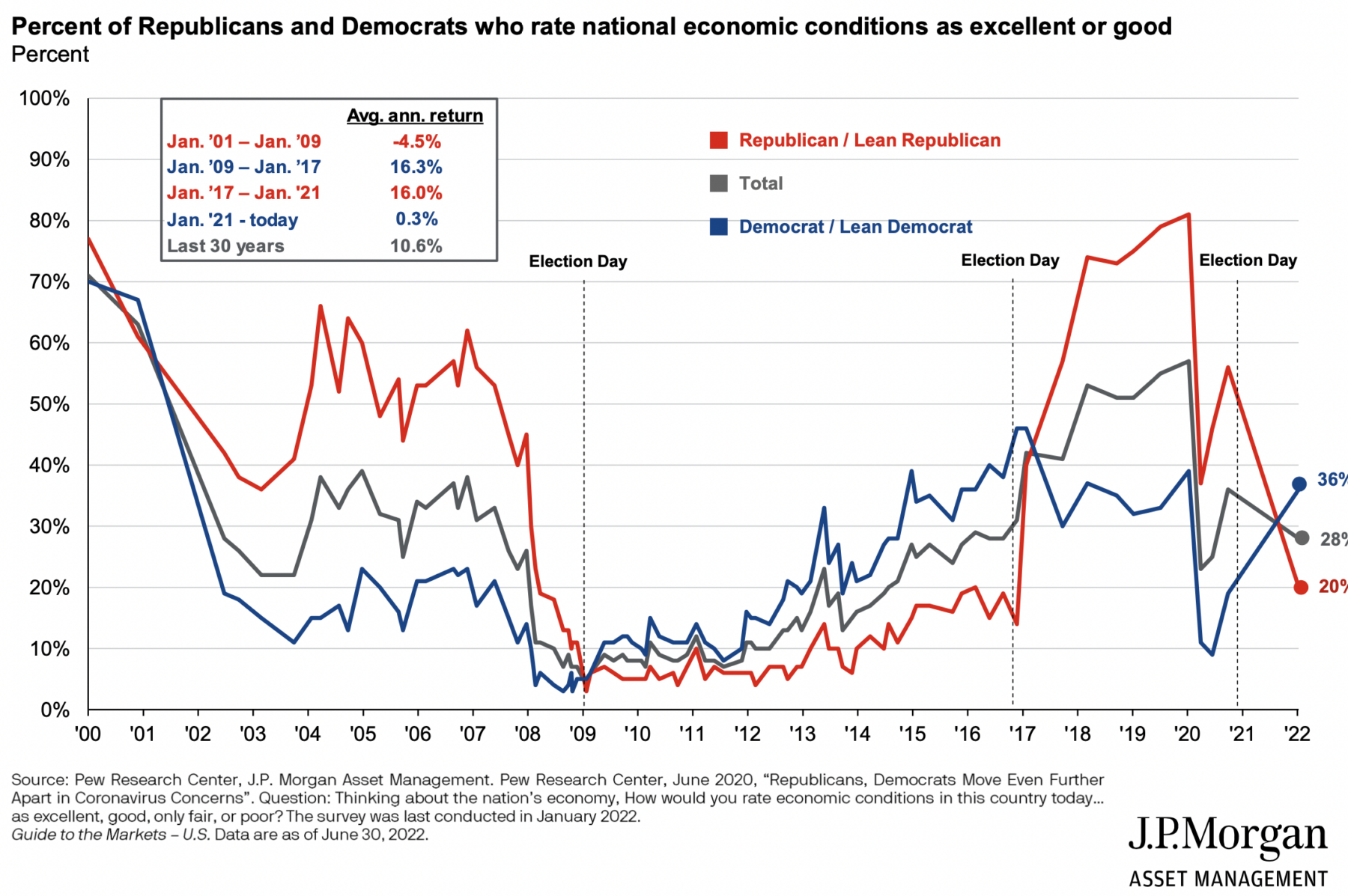Something odd happens every time the economy slides into a recession: Consumer Sentiment takes a shellacking, recovers, and then post-recession, crashes a second time.
I suspect it has something to do with the lagging nature of sentiment surveys: Perhaps it is the residual angst of the recession or distrust of the recovery.1
Readings in 2022 are the fourth such crash in sentiment following the recovery from a recession in recent decades. The chart above shows the University of Michigan Consumer Sentiment Index going back to the 1970s. Starting in the ’90s, there is an odd “echo crash” after each recession. I am unaware of any theory which explains why this sentiment phenomena occurs; perhaps it is the economic equivalent of PTSD, or maybe it reflects disappointment in how the economic recovery is going. Regardless, each recession recovery was subsequently followed by a substantial drop in sentiment.
Consider sentiment around the 1990 recession: After falling from 1989 highs of 97.9, sentiment crashed to a nadir of 63.9 in December 1990. By March 1991, it subsequently recovered to 87.7 before collapsing again to 67.5 in January 1992.
Anyone who took that 1992 sentiment collapse as a market sell signal left an immense amount of money on the table.
Similarly, prior to the 2001 recession, Michigan’s Sentiment rating peaked at 112.2 in January 2000. It fell to a recession low of 82.7 in October 2001 (post 9/11) before recovering to 96.9 in May 2002. The echo low was March 20032 at 77.6.
Markets subsequently doubled over the next 5 years.
The great financial crisis (GFC) recession was preceded by a sentiment peak in January 2007 of 96.9; Sentiment crashed to a low in November 2008 at 55.3, then rallied in February 2011 to 77.5 before seriously crashing in August 2011 to 77.8 – nearly identical to the GFC lows.
If you sold based on sentiment lows you missed a massive rally and the opportunity to triple your money in the S&P 500.
What about the current sentiment peak & crash? Pre-pandemic peak sentiment readings were at 101.0 in February 2020; they subsequently fell to 71.8 in April 2020. Here’s where things get kind of weird: After recovering from April 2021 to 88.3, they have subsequently collapsed to below pandemic lows to GFC levels of 58.4 in May 2022.
The pandemic recession and recovery have made everything unusual; this is not the typical post-recession expansion. Lots of cross currents and oddities have created a challenge in analyzing this economy using traditional models and rules.
I’m not suggesting that we ignore sentiment – Phil Gramm’s “mental recession” in 2008 showed us the dangers of that approach. However, the recent sentiment data seem strangely at odds with employment and wage data. James Mackintosh points out this seems to be wildly out of sync with reality, with a telling WSJ headline of “Consumers Say 2022 Is the Worst Economy Ever:”
“Households are the most depressed they have been since the University of Michigan began its long-running Consumer Sentiment index in the 1950s . . . The sanity check: Really? Worse than when lines of cars waited for hours for fuel in a deep recession in 1974, if it was even available? Worse than when unemployment was almost double the current level and inflation in double digits in 1980, with interest rates at 14.5%? Worse than after the 9/11 attacks, or when the global banking system was on the brink of failure in 2008? Come on.
The excess suggests other factors are at play beyond the economy: There is some data showing some of this is partisan — people’s assessment changes based on their political affiliation and which party is in power. But the big wildcard is more likely Inflation: It began moving aggressively higher in January 2021, and as of 2 quarters later around July of 2021, Sentiment was rolling over.
There is little doubt Inflation is a big key factor in the 2021-22 collapse. But that might make this sentiment crash deeper, but does not explain the echoes; I remain intrigued by the idea that following a recession, there are lingering resonance of emotional issues which lead to that second sentiment crash.
The psychology of surveys is that they are imperfect measures of what people imagine they believe or predict they’re going to do. This has been a problem with everything from holiday shopping surveys to pollsters to market sentiment. Regardless, we should never ignore a collapse in sentiment.
I can’t help but wonder if this pattern of an echo collapse in sentiment following a major recession is something valuable. Not only a reminder that sentiment is a lagging indicator, but also one that suggests a contrarian way to look at markets.
Update: Noon, July 7, 2022
JPM chart below reveals that partisanship can play a part in these consumer sentiment readings; note how much better people rate the economy when “Their Guy” is in the White House? I suspect this is part of the overall sentiment picture — but only one of several factors…
Previously:
Sentiment LOL (May 17, 2022)
Too Many Bears (May 3, 2022)
One-Sided Markets (September 29, 2021)
See also:
Consumers Say 2022 Is the Worst Economy Ever
By James Mackintosh
WSJ, July 6, 2022
__________
1. Sentiment is inherently backward-looking, but expectations questions are flawed for a different reason: people are terrible at forecasting the future, including what they will do (shop, vote, etc.) or how they will feel. But it does provide a snapshot of mood.
2. The US invasion of Iraq began in March 2003, and that is very likely a substantial source of negative sentiment.




